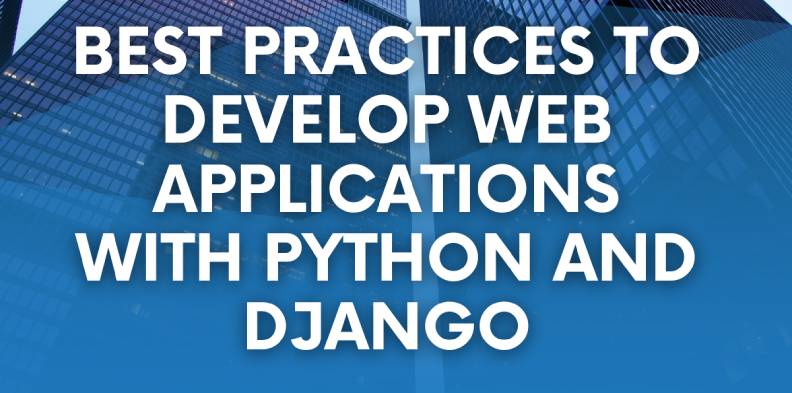Python development services are integral in web application development. Python is a versatile and widely acclaimed programming language in web application development. When coupled with Django, an efficient and high-level web framework, it becomes an exceptional choice for crafting dynamic and scalable web applications. This article delves into the essential strategies for proficiently developing web applications using Python and Django.
Crafting a Prudent Project Structure
The cornerstone of any successful Python development services is its underlying structure. The initial steps in your project should revolve around meticulous organisation. By dividing the project into reusable apps, each serving a specific purpose, developers can achieve better code organisation, modularity, and reusability. This allows for easier maintenance and scalability of the application. Here are some prudent practices for structuring your Django project:
-
Use Django’s Blueprint
Django provides a meticulously designed project structure segregating your application’s various components, including models, views, templates, and static files. Adhering to this blueprint ensures uniformity and facilitates comprehensibility for fellow developers.
-
Harness the Power of Apps
Django encourages the utilisation of modular apps, each serving a distinct purpose, such as user authentication or blog functionality. This modular approach simplifies maintenance and fosters the seamless integration of third-party apps.
-
Methodical Configuration Management
Isolate your project’s settings in a dedicated module, employing distinct settings files for different environments—development, testing, and production. This separation aids in configuration management and bolsters security.
Code Elegance and Efficiency
Python’s hallmark is its readability and simplicity, which Django fervently endorses. To ensure peak performance and maintainability, crafting elegant and efficient code is pivotal.
-
Adherence to PEP 8 Guidelines
A codebase adhering to Python’s PEP 8 style guide cultivates consistency and readability. This harmony makes it more accessible for both your development team and future maintainers to navigate.
-
Harness Database Query Optimization
Efficient database queries are the lifeblood of your web application’s performance. Leverage Django’s built-in query optimisation tools, such as select related and prefetch related, to curtail database queries and elevate response times.
-
Simplicity in View Logic
Maintain the simplicity of your views by keeping them focused on their specific tasks. Should a view burgeon in complexity, contemplate its subdivision into smaller, reusable functions or methods. This approach amplifies code maintainability and testability.
Security
In web application development, security is paramount. While Django furnishes numerous security features by default, it is incumbent upon developers to exercise best practices for fortifying their applications against vulnerabilities. Web application security is a critical aspect that should not be overlooked. Django offers multiple security features, which developers must implement to safeguard the application’s integrity. Django addresses prevalent vulnerabilities like cross-site scripting (XSS), cross-site request forgery (CSRF), and SQL injection.
-
Rely on Django’s Authentication System
Django provides a robust authentication system that deftly manages user registration, login, and password handling. The cardinal rule is to abstain from crafting custom authentication systems unless absolutely indispensable.
-
Shield Against Cross-Site Scripting (XSS)
Django’s template system automatically escapes content, mitigating the risk of XSS attacks. The best practice is to consistently employ Django templates for rendering HTML, thereby ensuring that user-generated content remains sanitised and secure.
-
Cross-Site Request Forgery (CSRF)
Django provides CSRF protection middleware and includes CSRF tokens in forms to prevent CSRF attacks.
-
SQL Injection
Django mitigates SQL injection through parameterised queries, query sanitisation, and database access abstraction.
-
Vigilance in Dependency Updates
Regularly update Python packages and Django to patch potential security vulnerabilities. Moreover, employ security scanning tools to identify and rectify lurking security issues within your codebase.
Python Development Services
To expedite and optimise your web application development journey, it’s prudent to consider Python development services. These services provide a wealth of expertise and resources to steer your project toward success.
-
Collaborative Synergy
Python development services bring specialised skills and experience to the table, enriching your project’s repertoire. Whether grappling with intricate features or overseeing project management, these services prove invaluable.
-
Scalability at the Core
Python development services assist in designing your web application with scalability as a core tenet. This ensures that your application is poised to accommodate increased traffic and burgeoning data gracefully.
-
Performance Optimization
Performance enhancement remains a perpetual endeavour. Python development services lend their expertise to pinpoint bottlenecks and fine-tune your application for optimal speed and responsiveness.
Rigorous Testing and Seamless Deployment
Comprehensive testing and seamless deployment culminate in delivering a reliable web application. Django provides a robust testing framework that allows developers to write unit, integration, and functional tests.
-
Crafting Robust Unit Tests
Lay the foundation for comprehensive unit tests that scrutinise the functionality of each component. Django’s testing framework facilitates the seamless creation and execution of tests.
-
Continuous Integration (CI)
Establish a robust CI/CD pipeline that automates testing and deployment procedures. Esteemed services like Jenkins, Travis CI, or GitHub Actions streamline the development lifecycle.
-
Post-Deployment Optimization
Following deployment, diligently monitor your application’s performance, error rates, and user feedback. Continual optimisation, guided by real-world usage data, ensures the continued refinement of your application.
Conclusion
Web application development with Python and Django presents an enticing mixture of simplicity, adaptability, and security. When you faithfully adhere to these best practices, you guarantee that your projects maintain a well-structured, secure, and future-ready posture for sustained success. Remaining attuned to the dynamic landscape of web development is crucial, as it ensures that your web applications withstand the test of time, serving users with excellence and innovation.





